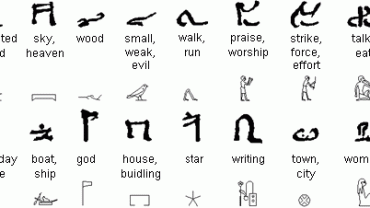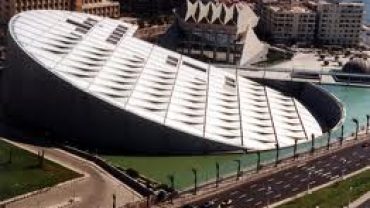The Karnak Temple complex is a huge ancient temple in Luxor, Egypt. It is one of the largest temple complexes in the world and is considered one of the most important ancient religious sites in Egypt. The complex consists of several temples, chapels, pylons and other buildings, many of which were built by various pharaohs over thousands of years.Karnak Temple
-Choose from over 50 offers of boat trips and historical excursions in Hurghada
Karnak Temple
The main temple at Karnak is dedicated to the god Amun and was built during the reigns of pharaohs such as Hatshepsut and Thutmose III. built. The temple features a massive pylon (entrance gate) that stands over 100 feet tall and a large open courtyard surrounded by pillars. Inside the temple are several chambers, including the Hypostyle Hall, a massive room with 134 columns that once supported the roof.
The history of the Karnak temple complex can be traced back to the Middle Kingdom period around 2055-1650 BC. Trace back. Over the centuries, pharaohs expanded the complex, making it one of the greatest religious sites of the ancient world. The temple was also an important center of the cult of Amun and played a significant role in the religious and political life of ancient Egypt.
The architecture of the Karnak Temple complex is a mix of styles from different eras, reflecting the many additions and renovations that have taken place over thousands of years. The massive pylons, towering columns and intricate carvings are examples of the architectural achievements of the ancient Egyptians. In addition to its architectural significance, the Karnak Temple complex is also notable for its many inscriptions, which provide valuable insights into the religious beliefs and practices of ancient Egypt.
Today, the Karnak Temple complex is a major tourist destination and one of the most popular attractions in Luxor. Visitors can explore the various temples and structures and admire the intricate carvings, paintings and inscriptions that adorn the walls and pillars. Tours are also available, providing a deeper understanding of the history and significance of this magnificent ancient site.
Fakten zum Karnak-Tempelkomplex:
Der Haupttempel in Karnak ist mit einer Fläche von mehr als 200.000 Quadratmetern eines der größten religiösen Bauwerke der Welt.
Die Säulenhalle ist mit ihren 134 Säulen einer der größten und beeindruckendsten Räume in einem antiken Tempel und ein gutes Beispiel für die architektonischen Errungenschaften der alten Ägypter.
Der Tempel war nicht nur ein Ort der Anbetung, sondern auch ein Zentrum der politischen Macht, wobei der Hohepriester des Amun einen bedeutenden Einfluss auf die altägyptische Gesellschaft ausübte.
Der Karnak-Tempelkomplex wurde nicht in einem Bauabschnitt fertiggestellt, sondern über einen Zeitraum von mehr als 1.500 Jahren gebaut, erweitert und modifiziert. Aus diesem Grund stellt der Komplex eine Mischung verschiedener Architekturstile aus verschiedenen Epochen dar.
Neben seiner religiösen Bedeutung hatte der Karnak-Tempelkomplex auch wirtschaftliche und militärische Bedeutung, da er das Zentrum des Amun-Kultes war, der den riesigen Reichtum kontrollierte, der in den Schatzkammern des Tempels angesammelt war, und für die Verteidigung der südlichen Grenze Ägyptens verantwortlich war.
Diese Fakten belegen die Bedeutung des Karnak-Tempelkomplexes für das religiöse, politische und kulturelle Leben des alten Ägypten und seine Bedeutung als eine der wichtigsten antiken religiösen Stätten der Welt.
What does the name Karnak mean? The origin of the name?
The name Karnak is believed to come from the Egyptian word «ka-arnak,» meaning «fortified village» or «fortress.» The ancient Egyptians referred to the temple complex as «Ipet-isut,» meaning «the holiest place.» .»
As you mentioned, the temple was dedicated to the worship of the god Amun, who was considered the king of the gods and the patron saint of Thebes. The temple was built over a period of more than 1,500 years, with each pharaoh adding new structures, decorations and inscriptions to the complex, making it one of the most important religious sites in ancient Egypt.
It is fascinating to see how the meaning and importance of the temple has evolved over time, reflecting the changing religious and political circumstances of ancient Egypt. The Temple of Karnak remains an important symbol of the greatness and achievement of the ancient Egyptian civilization and a testament to the importance of religion in shaping the history and culture of this ancient civilization.
Temple of Amun Re:
The Temple of Amun at Karnak is in fact named after the god Amun, who was considered the king of the gods and patron saint of Thebes. It is also known by several other names, as you mentioned, including «Ipet-isut,» which means «the holiest place.»
It is interesting to see how the names and significance of the temple changed over time to reflect the changing political and religious circumstances of ancient Egypt. The various names used for the temple demonstrate the importance and reverence that the ancient Egyptians placed on this site and its role as a center of religious worship and symbol of the power and authority of the pharaohs.
The inscriptions and drawings on the walls of the temple are a rich source of information for historians and archaeologists, providing insights into the beliefs, religious practices and daily life of the ancient Egyptians. They also serve as evidence of the incredible artistic and architectural achievements of this ancient civilization.
Why is the Karnak temple complex so famous?
The Karnak temple complex is also famous for its remarkable architectural achievements and the splendor of its halls and pillars. The complex consists of several pylons, each larger than the previous ones, forming a massive and impressive entrance. The Temple of Amun is surrounded by numerous obelisks, including the largest obelisk in Egypt, which is over 30 meters high. The walls of the temple are decorated with intricate carvings and reliefs depicting the pharaohs, the gods and various scenes of daily life in ancient Egypt.
Another reason why the Karnak temple complex is famous is its historical significance. It was a religious center and the site of many important events, including the coronation of new pharaohs and religious festivals. Many important inscriptions and hieroglyphs were found in the temple, providing valuable insights into the history and culture of ancient Egypt.
In conclusion, the Karnak Temple complex is famous for its size, grandeur, architectural achievements and historical significance, making it one of the most important and most visited tourist attractions in Luxor, Egypt.
Ritual temple:
Ritual temples were an important aspect of ancient Egyptian religion and served as centers of religious worship and ceremonies. These temples were dedicated to one or more gods and were the place where the daily rituals of these gods were performed. The priests performed the rituals, including offerings of food, incense, and other items to the gods to gain their favor and blessings.
In addition to religious ceremonies, ritual temples also served as a record of the reigning king’s achievements and events. These events were written on the walls of the temple and served as a kind of historical record for future generations.
Ritual temples were also often associated with the administration of the kingdom and played a role in the country’s political and economic life. They served as a symbol of the power and influence of the ruling dynasty and were often used to strengthen the king’s authority.
The size and splendor of these temples often reflected the wealth and prosperity of the kingdom and served as a source of pride and cultural identity for the ancient Egyptians.
Who built the Karnak temple complex?
The Karnak temple complex was built over a period of approximately 1,500 years, from the Middle Kingdom to the Ptolemaic Kingdom dynasty. The temple was originally built by King Sesostris I, and over time several pharaohs added and expanded the temple, making it one of the largest religious buildings in the world.
One of the notable pharaohs who added to the temple was Amenhotep III, who built a statue of himself that was 19 meters high and a third of a meter tall. The statue was later called «The Colossi of Memnon» by the Greeks, who believed that the statue produced a sound similar to the legendary hero Memnon. The temple was dedicated to the triad of gods Amun, Mut and Khonsu and symbolized the power of fertility and growth. The Sphinx Alley, depicting the god Amun, was also a significant feature of the temple complex.
History of Karnak Temple Complex:
At the time of the Middle Kingdom: The kings of the Eleventh Dynasty took the land of the Temple of Karnak as the site of construction of the great temple, where the White Chapel of the King of Sesostris I and the Court of the Middle Kingdom in the Temple of Karnak are located to this day , where King Sesostris I built the temple from 1971 to 1926 BC. Built with limestone.
During the New Kingdom: New Kingdom kings such as Tutmosis I, Hatshepsut, Tutmosis III, Sethi I and Ramesses II expanded the temple and added smaller temples. They used sandstone as their main building material, quarried from nearby Gebel Silsila. Hatshepsut also added a new entrance to the temple, the Hypostyle Hall, which contains 134 columns.
During the Ptolemaic Kingdom: The Ptolemaic Kingdom, ruled by the Greeks, also added the temple. They built a sanctuary for the goddess Isis and a temple for their ruler Ptolemy VIII.
Throughout its history, the Karnak temple complex has been used as a center for religious worship as well as a political and economic center. It was considered one of the most important religious sites in ancient Egypt and its massive size and intricate carvings make it a fascinating destination for visitors today.
The New Kingdom Era:
King Ramses II also added much to the temple, including two large obelisks, a pylon, and a number of smaller chapels dedicated to various gods. He also added many inscriptions throughout the temple complex, including scenes from his military victories and images of his achievements.
King Sethi I built the Great Temple of Amun and the seventh pylon, while King Ramesses III. erected the eleventh pylon. The temple complex continued to grow and develop under the rule of various pharaohs throughout the New Kingdom and even into the Ptolemaic period.
Despite its long history and various expansions and renovations, the Karnak Temple complex remains one of the best-preserved and most magnificently preserved examples of ancient Egyptian temple architecture. Its various pylons, halls and chapels testify to the temple’s religious and cultural significance, and its inscriptions and artwork provide insight into the beliefs, customs and daily life of the ancient Egyptians.
Karnak temple complex from the inside:
The temple begins at the first pylon of King Nectanebo I of the Thirtieth Dynasty and from there to the great court, then to three resting chapels of divine boats of the Thebes of the ancient capital, and from there to the Great Hypostyle Hall, which contains 134 columns taller than the Rest of the columns. Then there is the obelisk of Thutmose I, then the obelisk of Queen Hatshepsut, then the sanctuary, and then we reach the courtyard, which dates back to the Middle Kingdom period, then the huge hall of a temple festival with polychrome columns from the period of King Thutmose III “Ballroom of Thutmose III.”. Situated on a large area, the Temple of Karnak covers approximately 200 hectares (1.5 km by 0.8 km) and has been in use since 2,000 BC. a place of pilgrimage.
In addition, the Karnak Temple complex is a site of great architectural significance and showcases the remarkable artistic and technical skills of the ancient Egyptians. It contains many monumental buildings, including pylons, temples, courtyards, halls, sanctuaries and obelisks, all displaying the intricate details and artistic craftsmanship of the ancient Egyptians. The walls of the temple are decorated with ornate carvings depicting religious scenes and inscriptions, as well as depictions of the pharaohs who contributed to the construction of the temple. The Karnak Temple complex is truly a remarkable testament to the ingenuity and creativity of the ancient Egyptians and continues to fascinate visitors from around the world to this day.
Karnak temple complex
It is definitely a worthwhile experience to visit the Karnak temple complex and learn more about its rich history and culture. It is a true testament to the skill and ingenuity of ancient Egyptian architects and builders, and the enormous size and intricate details of the temple complex make it a breathtaking sight. Don’t forget to see the famous Hypostyle Hall and admire the 134 columns that still stand tall after thousands of years. The Opet festival is also a unique aspect of the temple’s history and shows the close connection between the pharaohs and the gods in ancient Egyptian society. Visiting the temple with a guide will allow you to gain a deeper understanding of the temple’s significance and its place in the history of ancient Egypt.
The Avenue of the Sphinxes:
Karnak Milky Way Temple: Sphinx-Aries Road on both sides «Sphinx-Ramses II Road or Aries Road»: The Karnak Temple complex contains 3 Aries Roads known as Sphinx Road, the first containing Luxor Temple and Karnak on one length of 3 km connects, the second is at the entrance and most of the statues were destroyed and restored by the Egyptian Ministry of Tourism and Antiquities, and the third connects the Temple of Amun and the Temple of Mut. The method was built during the reign of King Nekhtanebo I, one of the pharaoh-kings of the 30th Dynasty, and connected the temple of the god Khonsu south of the Karnak complex with the Luxor Temple, a stone-floored street on both sides There were 34 stone statues in the shape of the famous Sphinx statue. There are explanations that the Sphinx Alleys replaced the old Sphinx Alley that King Amenhotep III. where the king painted his name on the south gate of the Temple of Khonsu to learn more about the architecture of ancient Egypt. The statues were built and designed in a distinctive and unique artistic style, with the architects crafting a sandstone block for the head of a lion in reference to King Nekhtanebo, then installing the statue on a rectangular base and using the alley as a route to the official royal or divine procession applies to learn more about the art of painting in ancient Egypt and sculpture in ancient Egypt. There are sphinxes left and right, and here you can pick up the coolest souvenirs with the huge statue of Ramses II and the world’s largest hypostyle room of its kind to learn more about the architecture of ancient Egypt. You can also enjoy the ancient hieroglyphs and drawings engraved on the pillars and obelisks of King Thutmose I and Queen Hatshepsut, whose meanings are explained in several languages by the tour guide. Finally, the temples of Amun and King Ramses III can be visited, then the sacred lake, the holy city and the luxurious royal palaces of the Temple of Karnak itself, the sound and light show at night in which the Temple of Karnak reveals its ancient history and tells the story of the ancient city of Luxor.
The Avenue of the Sphinxes:
Architecture of the Karnak Temple Complex: The Temple of Karnakhas 10 monuments, six of which have an east-west axis and four have a north-south plow which looks like this… Pylon 1: unfinished Pylon II: Ramses II and Sethi I Pylon 3: Amenhotep III Pylon 4: Thutmose I Pylon 5: Thutmose I Pylon 6: Thutmose III Pylon 7: Thutmose III Pylon 8: Hatshepsut Pylon 9: Horemheb Pylon 10: Horemheb.
In addition to these pylons, the temple also features a number of other impressive structures and architectural elements, including the Hypostyle Hall, the obelisks of Thutmose I and Hatshepsut, the festival hall of Thutmose III, the Middle Kingdom court, the sanctuary, the resting chapels of the divine boats and more.
One of the key architectural features of the Karnak temple complex is the use of columns. The Hypostyle Hall in particular is known for its 134 columns, which are among the largest in antiquity. These pillars are decorated with intricate carvings and reliefs depicting scenes from Egyptian mythology, as well as inscriptions and dedications to various gods and pharaohs.
The temple is also known for its elaborate system of sacred pools and lakes that were used for religious rituals and ceremonies. The pools were surrounded by storage rooms and living quarters for the priests, and the water was believed to be blessed by the gods and provide a source of divine energy to those who bathed in it.
The Karnak Temple complex is truly a marvel of ancient architecture and engineering and is considered one of the most impressive and important ancient sites in the world. Whether you are an archaeologist, historian or just a lover of ancient cultures, a visit to this magnificent temple is an experience you will never forget.

Ancient Temples in Karnak Temple Complex: The Sacred Lake The Chapel of Alexander the Great Group of Osirian Chapels Temple of Amun-Ra Chinon Temple Temple of Khonsu Temple of Ptah The Festival Hall
of Thutmose III. The sacred lake, also known as Isheru, is an important religious feature of the Karnak temple complex. It was used for purification ceremonies and religious rituals.
The Chapel of Alexander the Great was built in the 4th century BC. Built in 500 BC to commemorate the visit of the Greek conqueror Alexander the Great to the temple. The chapel is located in the heart of Karnak Temple and is dedicated to the god Amun-Ra.
The group of Osirian chapels is dedicated to the god Osiris, god of the underworld, and is located to the northeast of Karnak Temple. The group includes several chapels and a sacred lake that was used for religious rituals and ceremonies.
The Temple of Amun-Ra is the main temple of the Karnak temple complex and is dedicated to the god Amun-Ra, the king of the gods. The temple has several chapels, a hypostyle hall and a sacred lake.
The Temple of Khonsu is dedicated to the god Khonsu, the moon god, and is located south of Karnak Temple. The temple was built during the reign of King Ramses III. Built and is considered one of the most important temples in the Karnak temple complex.
The Temple of Ptah is dedicated to the god Ptah, the god of creation, and is located in the northern part of the Karnak temple complex. The temple was built during the reign of King Thutmose III. Built and is considered one of the oldest temples in the Karnak temple complex.
The festival hall of Thutmose III. is a large hall located in the Karnak temple complex that was used for religious festivals and ceremonies. The hall is considered one of the most impressive structures in the temple and is decorated with beautiful reliefs and sculptures.
Karnak Temple Complex Plan/Map:
Grand Processional Way: It is a long, wide path that leads to the Temple of Amun-Ra. It is lined with massive pillars and shows the remains of the sacred lakes on both sides.
First Square: This is the first of the three large open-air squares and is surrounded by massive pylons and impressive columns. It was used for festivals and religious ceremonies.
Hypostyle Hall: This is the largest room in the Temple of Amun-Ra and is located behind the first courtyard. It has 134 massive columns with capitals in the shape of papyrus or lotuses.
Temple of Amun-Ra: This is the main temple of the complex and is dedicated to the god Amun-Ra. It features a number of sanctuaries and a large hypostyle hall.
Temple of Khonsu: This temple is dedicated to the god Khonsu and is located south of the Temple of Amun-Ra. It features a number of sanctuaries and a hypostyle hall.
Temple of Ptah: This temple is dedicated to the god Ptah and is located near the Temple of Amun-Ra. It features a small hypostyle hall and a number of sanctuaries.
Sacred Lake: This is a large artificial lake near the Temple of Amun-Ra. It was used for religious purification rituals and for storing sacred boats.
Chapel of Alexander the Great: This is a small chapel dedicated to Alexander the Great, who visited the temple during his conquest of Egypt. It features a relief depicting the king making offerings to the gods.
Group of Osirian Chapels: These are a series of small chapels dedicated to the god Osiris. They contain offerings and inscriptions dedicated to the god.
Festival Hall: This is a large hall near the Temple of Amun-Ra. It was used for religious festivals and ceremonies.
Karnak Open Air Museum:
Karnak Open Air Museum: The height of the first tower at the entrance to Karnak Temple is 31 meters and the second tower is 21 meters. It includes space to display flags during celebrations. After the first tower we find a large open courtyard with an area of 100 * 85 meters, where there is a huge statue of King Ramses II and his daughter Princess Nefertari, the temple of King Ramses III. and King Taharqa’s Kiosk. The first pylon barge shrine of King Seti II. Mudbrick ramp King Taharqas Kiosk Temple of King Ramses III. Statue of Ramses II. The second pylon The Great Hypostyle Hall Obelisk of King Thutmose I. Fourth Pylon Fifth Pylon The portico of King Thutmose I, the vestibule and the anteroom of King Thutmose III. between the fifth and sixth towers. Obelisk of Queen Hatshepsut Sixth Pylon Holy of Holies Philip Arrhidius. Shrine of Queen Hatshepsut Thutmose III Festival Hall Botanical Garden Temple of Ptah Mausoleum of Osiris Sacred Lake Cachet Courtyard The Seventh Pylon The courtyard between the seventh and eighth towers. White limestone statue in front of the eighth pylon. The Eighth Pylon The Ninth Pylon The Tenth Pylon Mot Temple Khonsu Temple Gate of King Ptolemy III. Road of the Ram Sphinx between Karnak Temple and Luxor Temple.
Chapel of Alexander the Great
Sanctuary of Amun
Kiosk of Nectanebo I
Temple of Sethi I
Obelisk of King Senusret I
Chapel of Osiris.
Great pillared hall in the Karnak Temple complex:
The Great Hypostyle Hall in the Karnak Temple complex is considered one of the largest religious structures in the world and is considered a masterpiece of ancient Egyptian architecture. The pillars in the hall are decorated with intricate carvings of lotus, papyrus and other Egyptian symbols and motifs. The hall was used for religious ceremonies, festivals and meetings. The hall is also a symbol of the power and wealth of the pharaohs, who expanded it over the centuries, making it one of the most important parts of the Karnak temple complex.
Khonsu Temple:
The Temple of Khonsu is located in the Karnak Temple complex in Luxor, Egypt. It was dedicated to the god Khonsu, son of Amun and Mut and the god of the moon and time. The temple has three main halls, the first of which is the entrance hall, decorated with scenes depicting King Ramses III. makes offerings to the gods. The second hall is the Hypostyle Hall, built by King Nakhtanibo I and containing 12 columns with scenes of the King Khonsu making offerings. The third hall is the sanctuary built by King Sethi I and contains several baboon statues symbolizing the god Thoth, who was associated with Khonsu. The temple of Khonsu was used for religious rituals and ceremonies, including the god’s annual festival, celebrated at the beginning of the lunar month each year.
Hatshepsut Obelisk in Karnak Temple Complex:
The Obelisk of Queen Hatshepsut is one of the largest obelisks in the Karnak Temple complex. The temple houses drawings from the Battle of Kadesh, known between the reign of the pharaonic king Ramses II, and the inscriptions of the peace treaty between Ramses II and the Hittites. Inside the Temple of Karnak is the chapel of the pharaonic queen Hatshepsut, which contains a hypostyle room followed by a street. Behind the first pylon are two obelisks for King Thutmose I and Queen Hatshepsut, the largest obelisks in Egypt to date. The temple of the god Amun is uniquely designed, especially the Great Hypostyle Hall in which it is located, and archaeologists say that the size of the hall is larger than the size of Notre Dame Cathedral in Paris, France. Some archaeologists explain that more than 100 men can sit above the hypostyle room, which is shaped like an open papyrus flower. After leaving the room, you go to a very wide rectangular courtyard that leads you to the sanctuary, which was only reserved for priests and kings during the time of the pharaohs. Many important temples of the pharaohs, the temple of the goddess Mout, the temple of Ptah, the god of Memphis and Monthou, the god of war, were defeated by the ancient Egyptians of the pharaonic civilization. In front of the pylon of the funerary temple of the pharaonic king Amenhotep III. There is a statue of Grateful. The Temple of Karnak is one of the most important places for the ancient Egyptians from the inside and was called «some bot or some fool», in addition to the temples were built on an area of 100 hectares. Karnak Sound and Light Show is currently presented to tell the story of the construction of the unique temples of Karnak in more than one language (Arabic, English, French, German, Spanish, Italian, Japanese).
Karnak Temple Complex:
The Karnak Temple complex is considered one of the largest temple complexes in the world and one of the most important religious and cultural sites in Egypt. The temple was built and expanded by various pharaohs over thousands of years, making it a unique example of the development of ancient Egyptian architecture.
Visitors to the Karnak Temple complex can also see the Temple of Amun, the Temple of Ptah, the Temple of Monthu, and the Temple of Khonsu, each dedicated to different gods and goddesses of ancient Egypt.
One of the most impressive features of the Karnak Temple complex is the Great Hypostyle Hall, known for its massive columns decorated with intricate patterns and decorated with hieroglyphs. The Hypostyle Hall at Khonsu Temple is also a popular attraction, with its beautiful carvings and well-preserved paintings.
In addition to its religious and architectural significance, the Karnak temple complex was also a source of valuable historical information. Archaeologists have discovered many inscriptions and artifacts within the complex that provide insight into the beliefs, customs and daily life of the ancient Egyptians.
Visitors can enjoy a sound and light show at the Karnak Temple complex, presented in multiple languages, providing an immersive experience that brings the history and culture of the ancient Egyptians to life.
Overall, the Karnak Temple complex is a must-see for anyone interested in ancient history and culture, and it remains a lasting testament to the skill and ingenuity of the ancient Egyptians.
Sacred lake in the Karnak temple complex
The sacred lake in the Karnak temple complex was also used for religious rituals and ceremonies such as the Festival of Opet. During this festival, the statue of the god Amun was taken from the temple to the lake for purification.
It was also believed that the lake was connected to the Nile and that the water from the lake had the power to heal and heal.
The sacred lake was surrounded by mud-brick walls and was a significant part of the Karnak temple complex. It was considered a symbol of the land’s fertility, and the ancient Egyptians believed that the lake’s water was associated with the afterlife.
Visitors today can still see the remains of the sacred lake and the mud-brick walls, which provide insight into the religious and cultural practices of the ancient Egyptian civilization. The place is also a popular tourist attraction and attracts thousands of visitors every year.
Karnak Temple Complex Opening Hours:
Open daily from 7:00 a.m. to 5:00 p.m.
Location of Karnak Temple Complex:
East bank of the Nile, north of Luxor Temple, Luxor, Egypt.
Karnak Temple Complex Ticket Price:
Foreigner:
Adults: EGP 220
Students/children 6-10 years: EGP 110
Egyptians/Arabs:
Adults: EGP 40
Students/children 6-10 years: EGP 20
It is important to note that these prices and opening times are subject to change and it is always a good idea to check the official website or a local tourist information center for the most up-to-date information before planning your visit.
FAQ’S:
Is Karnak the largest temple in the world?
No, Karnak Temple is not the largest temple in the world. Although it is one of the largest temple complexes in the world, there are other temple complexes that are larger. For example, the ancient city of Angkor in Cambodia is home to the Angkor Wat temple, the largest religious monument in the world.
Are Karnak and Luxor temples the same?
No, Karnak Temple and Luxor Temple are not the same. The Karnak Temple is located in the city of Luxor and is considered one of the largest temple complexes in the world. Luxor Temple, on the other hand, is a separate temple in the city of Luxor, about 2 kilometers away from Karnak Temple. While both temples were built by the ancient Egyptians during the Pharaonic period, each temple has its own unique architectural design, history and religious significance.
the study of ancient Egypt and its civilization is known as Egyptology. Egyptology covers a wide range of topics, including the history, religion, culture and everyday life of the ancient Egyptians. It also includes the pharaohs and their rule, the gods they worshiped, and the monumental architecture they built, such as temples, pyramids, and obelisks.
Egypt is home to a rich and diverse history, which is reflected in the many historical sites and monuments throughout the country. From the famous pyramids of Giza, the Sphinx and the temples of Luxor and Karnak to the Islamic and Coptic antiquities in various cities, Egypt has something to offer everyone interested in history and archaeology.
By exploring the various historical sites and monuments in Egypt, one can learn the secrets of the kings of the pharaohs, their lives and the civilizations they ruled. Studying Egyptology provides a window into the past, allowing us to understand the beliefs, customs, and lifestyle of one of the world’s greatest ancient civilizations.
How are Karnak and Luxor connected?
Karnak and Luxor are linked by their proximity and historical importance in ancient Egyptian civilization. Karnak Temple is located on the east bank of the Nile, north of Luxor Temple. The two temples were part of a larger religious complex dedicated to the god Amun and his wife Mut in Thebes (modern-day Luxor). Visitors often visit both temples during their trips to Luxor as they are considered two of the most important and best-preserved ancient Egyptian sites in the world.
What is the name of the temple in Luxor?
The temple in Luxor is officially called the Luxor Temple.
What is the name of the temple in Karnak?
The temple in Karnak is called the Temple of Karnak. It is one of the largest and most complex ancient religious sites in the world, dedicated to the god Amun and other Egyptian gods. The temple complex was built and expanded over many centuries and was an important religious center for the ancient Egyptian civilization.
Why is Karnak Temple so famous?
Karnak Temple is one of the most famous temples in the world due to its size, complexity and historical significance. Considered the largest religious complex in the world, it was built over a period of approximately 1,500 years from the Middle Kingdom to the Ptolemaic period. The temple contains a large number of structures, including several halls and pylons, obelisks and statues of various gods and pharaohs. Its size and grandeur are a testament to the wealth and power of the ancient Egyptian civilization. In addition, Karnak Temple is famous for its many inscriptions and works of art, which provide valuable insights into the religious, political and cultural history of ancient Egypt.
For whom was the Temple of Karnak built?
The Temple of Karnak was built for the god Amun, one of the most important deities in the ancient Egyptian pantheon. It was also a place for the worship of other gods, such as Mut and Khonsu. The temple was considered the center of the religious world in ancient Egypt and was one of the most important religious sites in the country. It was also a symbol of the power and wealth of the pharaohs who ruled the land and was expanded and modified by many of them over thousands of years.
Why is Karnak important?
Karnak Temple is important for several reasons:
Age: Karnak is one of the oldest and largest religious temple complexes in the world, parts of which are over 4,000 years old.
Size: The temple complex covers an area of over 100 hectares and is home to a variety of buildings, courtyards and temples.
Religious Significance: Karnak was dedicated to the worship of the god Amun and was one of the most important religious sites in ancient Egypt. It was also a place of pilgrimage for Egyptians from all over the country.
Architecture: The temple complex showcases some of ancient Egypt’s most impressive architectural feats, including the Great Hypostyle Hall with 134 soaring columns and the Obelisk of Queen Hatshepsut, which is one of the largest obelisks in Egypt.
Historical Significance: Karnak was a place of political and religious power for over 2,000 years and was a key center for the cult of Amun during the New Kingdom period.
Overall, Karnak Temple is a testament to the grandeur and architectural sophistication of ancient Egyptian civilization and remains a major tourist attraction and a source of fascination for historians and archaeologists.

Karnak Tempel
































Comment (0)